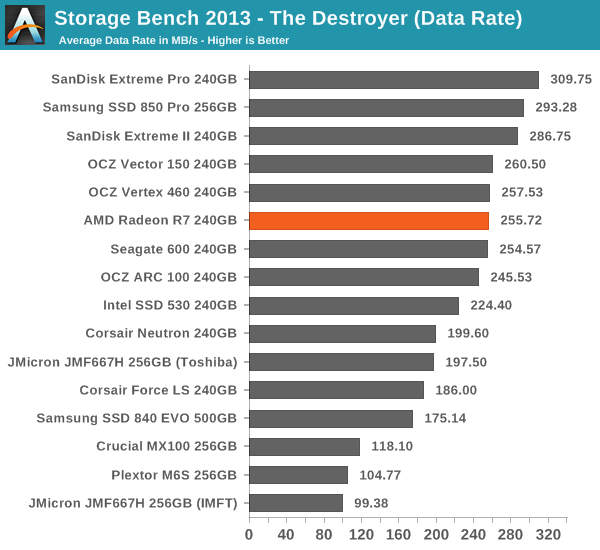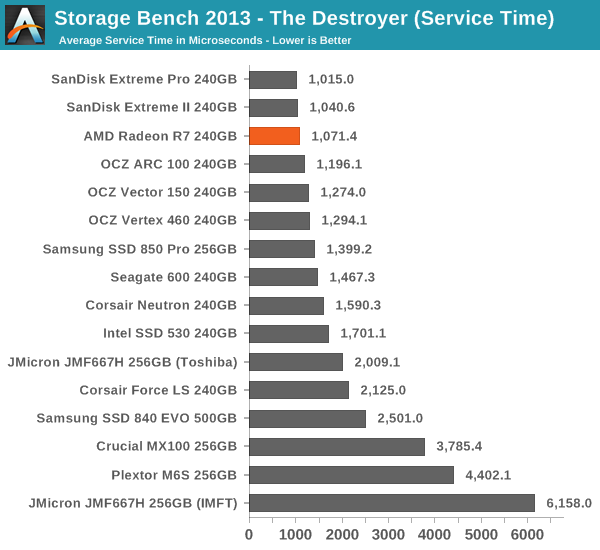AMD Radeon R7 SSD (240GB) Review
by Kristian Vättö on August 28, 2014 6:00 AM ESTAnandTech Storage Bench 2013
Our Storage Bench 2013 focuses on worst-case multitasking and IO consistency. Similar to our earlier Storage Benches, the test is still application trace based – we record all IO requests made to a test system and play them back on the drive we are testing and run statistical analysis on the drive's responses. There are 49.8 million IO operations in total with 1583.0GB of reads and 875.6GB of writes. I'm not including the full description of the test for better readability, so make sure to read our Storage Bench 2013 introduction for the full details.
| AnandTech Storage Bench 2013 - The Destroyer | ||
| Workload | Description | Applications Used |
| Photo Sync/Editing | Import images, edit, export | Adobe Photoshop CS6, Adobe Lightroom 4, Dropbox |
| Gaming | Download/install games, play games | Steam, Deus Ex, Skyrim, Starcraft 2, BioShock Infinite |
| Virtualization | Run/manage VM, use general apps inside VM | VirtualBox |
| General Productivity | Browse the web, manage local email, copy files, encrypt/decrypt files, backup system, download content, virus/malware scan | Chrome, IE10, Outlook, Windows 8, AxCrypt, uTorrent, AdAware |
| Video Playback | Copy and watch movies | Windows 8 |
| Application Development | Compile projects, check out code, download code samples | Visual Studio 2012 |
We are reporting two primary metrics with the Destroyer: average data rate in MB/s and average service time in microseconds. The former gives you an idea of the throughput of the drive during the time that it was running the test workload. This can be a very good indication of overall performance. What average data rate doesn't do a good job of is taking into account response time of very bursty (read: high queue depth) IO. By reporting average service time we heavily weigh latency for queued IOs. You'll note that this is a metric we have been reporting in our enterprise benchmarks for a while now. With the client tests maturing, the time was right for a little convergence.

Performance in our 2013 Storage Bench is typical Barefoot 3, although it appears that both the R7 and ARC 100 are more optimized for small IOs given that they provide a lower service time, yet the data rate is marginally slower.











54 Comments
View All Comments
LB-ID - Thursday, August 28, 2014 - link
It would be amusing if consumers weren't being harmed by this. OCZ has such a deservedly poor reputation that they're turning to rebranding to try to foist their crap on an unsuspecting audience. No way, and I'll warn anyone who will listen about this. Shame on AMD for partnering with such an unscrupulous vendor.errorr - Friday, August 29, 2014 - link
Well considering most of there less than scrupulous employees are not part of a completely new subsidiary of Toshiba...kyuu - Tuesday, September 2, 2014 - link
OCZ is now owned by Toshiba, and their current drives work well. Continuing to harp on the old OCZ and their bad line of drives is silly. There's nothing "unscrupulous' about OCZ nowadays.ronnyzigzag - Thursday, August 28, 2014 - link
I'm not the most knowledgeable when it comes to screen resolution specs,but I will tell you that whenI first saw homepage and when I watched my first video on Netflix,I was very satisfied with hat I saw.It looked great.Since watching a ten inch screen from only a couple of feet away,makes the screen size seem to appear the same sizeas if you were in a real movie theater ,it didn't seem to matter to me.And one more thing ,it looks and feels great so go and get one for yourselves and enjoy!pt2501 - Thursday, August 28, 2014 - link
Bought a vertex 3 during Thanksgiving 2011, I knew it was risky but the performance could not be beat at the time. It is still my primary boot drive and going strong 3 years later. I really can't complain and in my book OCZ is still okay.LiviuTM - Friday, August 29, 2014 - link
No doubt OCZ is a top SSD manufacturer, now that it has full access to Toshiba resources and NAND.The main problem of this drive is pricing, as Kristian said. :)lilmoe - Friday, August 29, 2014 - link
"For someone with very little or no understanding of computers, the AMD branding can provide a peace of mind since AMD is fairly large and visible brand in the industry"Actually, if I had to say, I think this title goes to Kingston. ADATA and Sandisk have been coming in close second as of late. The average Joe is going to brands they recognize for RAM and flash...
jabber - Friday, August 29, 2014 - link
I would say AMD does not have a large and visible brand in the industry...that counts for anything.Assk 100 random Joes in the street if they know of Intel or AMD and I bet 85 of them will know about Intel "Oh they make computers don't they?" and maybe 5 might actually know what AMD do.
Crdlp - Monday, September 1, 2014 - link
I've never had issues with an ocz product. I've build several computer computers with there ram sticks, power supplies, and old (sanforce) and new ssds. I did have a power supply go out when it got struck by lightning. There old ram and power supplies got the job done on a budgit computer, and now there ssds to me represent a small company competting with much bigger companies, and winning much of the time. The only issues they had was with sanforce controllers, and for some reason, people forget that every sanforce drive (which was most drives then) was having the same issues, but people seem to only like to blame ocz for it. They were one of the only brands that decided to take steps to move away from relying on another company to provide a controller for them, which was expensive. Toshiba did not aquire ocz because they needed a ssd in the market, they already had one. Ocz is a small company, that has a realitivly amazing drive, it was a matter of time before somebody bought them.Clubber Lang - Sunday, September 7, 2014 - link
I have 5 OCZ SSD Primary Boot drives that have been in use since 2009/2010, and not one has failed.Quite frankly I think a lot of people back then were ruining their SSD's by defragging them to death. (Auto defrag used to be on by default)